Valgus deformation of the leg thumb is the most common orthopedic disease.Its main feature is the curvature of the 1 plusnefalanx joint.In the early stages, it manifests itself in the form of small growth near the thumb.Pathology has slow development, so it is quite difficult to diagnose it in the initial stages.Valgus deformation is often combined with violation of tissue blood supply, leading to the development of arthritis or arthrosis.In the absence of treatment in the thumb joint, an acute inflammatory process is called Bursite.
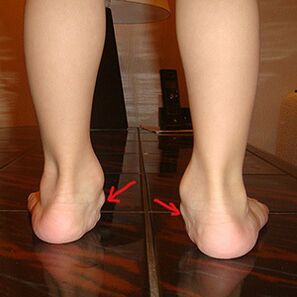
What contributes to the curvature of the finger?
The causes of the valgus deformation may be different, the main among them is the following:
- flat foot;
- Congenital pathologies of the plusnoplange joint;
- muscle weakness leading to abnormal mobility of bone surfaces;
- foot injuries;
- Destruction of cartilage against the background of arthritis or arthrosis.
It is not subject to direct causes of the disease occurring, but may accelerate the development of the pathological process.Therefore, Khalus valgus is most often found in women.There are other pathological reasons that cause the first finger of the foot to bow.Osteoporosis develops when calcium is washed from bone tissues, which makes them less dense.This leads to a change in the shape of the joint.Almost every person with the symptoms of the Valgus deformation has one of the flat feet.Endocrine disorders contribute to a reduction in the strength of the leagues and therefore cannot keep the joint in the right position.The risk group includes women who are used to walking in high biscuits.The increased loads of the toes accelerate the process of curvature of the joint.Ballet dancers are forced to stand for a long time in the socks, which can lead to leg deformation.So the deformation of Valgus is found in only 3% of people under the age of 30, while five of the elderly have similar problems.This disease is most often found in patients whose parents were the pathologies of the muscle bone system.
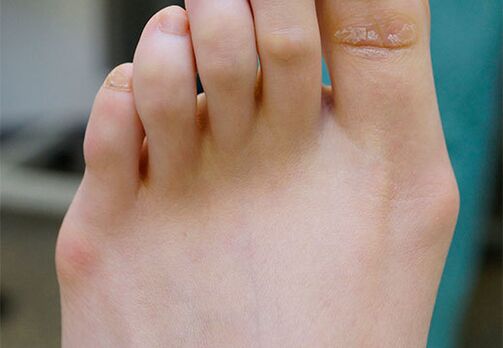
A clinical picture of the disease
The curvature of the leg thumb in the initial stages is quite difficult to notice.A person notices that he becomes uncomfortable in the usual shoe.After a long stay in a constant position, pain syndrome occurs.Over time, the main sign of pathology appears - the deviation of the first metatarsophalangeal joint towards the second, with the formation of a cone called SO.The other fingers develop with a hammer.The patient may experience chronic fatigue and difficulties in choosing a shoe.Over time, corn appears on the skin of the feet and causes a lot of discomfort for humans.The most common signs of valgus deformation are painful feelings about synovial membrane inflammation.The first finger shows a soft seal.The skin in the affected area blushes and swells.Over time, bone corn is formed, irritating soft and cartilage.There are severe pain during walking.The joint mobility is limited and the abnormal process covers all the fingers of the foot.
There are many degrees of degory deformation, each of which has its own symptom:
- Degree Hallux valgus is characterized by curvature of the finger, up to 20 °.There is no pain at the same time.
- In the case of a 2 degree disease, the joint shifts by 21-30 °.The discomfort is mild and the mobility of the finger is not disturbed.
- With the deformation of degrees 3, the angle of curvature exceeds 30 °.The pain in the affected area gets a constant character.Prevent people from wearing familiar shoes, walking and exercising.
- During the 4 stages of the disease, the joint shifts by more than 50 °.The deformation of this degree is characterized by severe pain, difficulties in the selection of shoes, and the formation of corn.
How did this disease be revealed
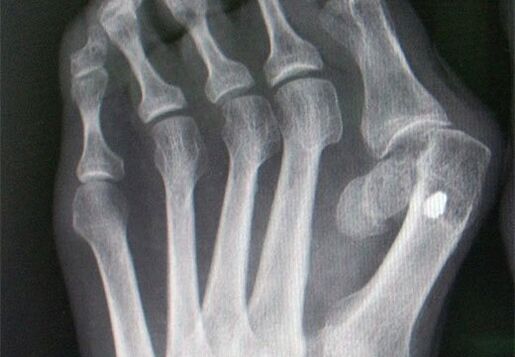
For preliminary diagnosis, we examine the history of the leg and anamnisis.To the doctor:
- Evaluate the severity of the change of walking;
- The degree of joint curvature;
- presence of corn;
- Bone suppositories.
The main therapeutic measures
The choice of a particular method depends on the degree of deformation of the joint and the severity of the pain syndrome.The most effective treatment of the leg thumb in the early stages.Therapy can be conservative and surgical.In additionThe formation of the pathological process.Specialty inserts and seals to reduce pressure on the affected area.Due to the large number of side effects, these funds are not suitable for longer use.Medication is not able to completely save a person from valgus deformation.It allows you to remove only pain and signs of inflammation.Physiotherapeutic procedures are often used to treat the disease - diater or ultrasound.However, these methods only result in temporary relief.The most effective is the use of orthopedic tools, which are made with the individual characteristics of the foot.The use of fans and fingers in the early stages of the disease prevents further joint deformation.With the advanced forms of the disease, orthopedic devices allow you to make walking more comfortable.With special insoles, you can eliminate the main cause of curvature - flat legs.Surgery is usually required for deformation of 3-4 degrees if conservative treatment is ineffective.The choice of method depends on the severity of the deformation.With a slight displacement of the finger, only bone growth is removed.To do this, a small incision is performed in the affected area, then the bump is cut and removed.
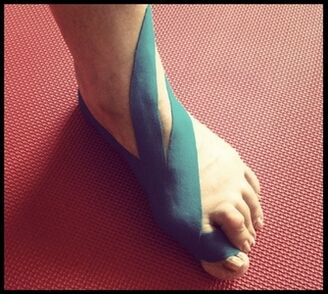
The purpose of distal osteotomy is to reduce the angle of curvature.The lower part of the bone is dissected and installed in the right position.Proximal osteotomy has an effect on the upper part of the finger.During the operation of the Keller - the thumb of the thumb is completely removed, the remaining synovial shell is placed between the plus bone and the main phalanx.Surgery interventions are used in the advanced forms of valgus deformation in most cases.The efficiency of the treatment depends highly on the correctness of the implementation of rehabilitation measures.During the postoperative period, we should wear solid shoes or use special tools.To reduce the load on the operated leg, crutches should be used.Shoes should be a wide toe and low heels.It should be remembered that surgical intervention can lead to complications.
The most dangerous are:
- soft tissue infection;
- osteomyelitis;
- bleeding;
- Displacement of bone fragments;
- Slowing down healing processes;
- Loss of sensitivity to fingers.
Other rare complications are avascular neurosis and post -traumatic arthritis.Prevention of Valgus deformation is a constant visit to orthopedics.The wearing of high heels must be rejected.Orthopedic insoles are recommended.Long stay is forbidden in a permanent situation.Valgus deformation is a fairly serious disease that can exacerbate the quality of the patient's life, so it should begin early in the treatment.
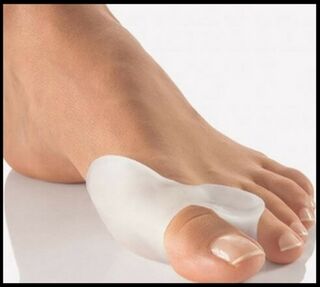
Khalus Valgus (Hallux Valgus) Treatment Without Surgery
Excessive body weight, wearing uncomfortable shoes, the trauma of the legs leads to the appearance of the painful, hyperemic protrusion.It's called Hallux Valgus.What is Hallux Valgus?The definite expression literally deciphered as follows: Hallux thumb and valgus curvature.The protrusion is the medial part of the head of the first metatarsal bone.At the same time, it is gradually different from other metatarsal bones, which visually increases swelling.This disease is illustrated by severe pain, and it is impossible to wear the usual shoes.The skin above the protrusion is constantly rubbed, ignited and rarely bleed.With the early circulation of medical help, a significant deformation of all metatarsophangeal joints is done.The first and second fingers are crossed, other fingers can be bent unintentionally, while the extension becomes impossible.
The causes of illness
In order to better understand what Khalus valgus is, you need to know the causes and mechanism of the disease.Most often it develops in women because their ligasin device is not as strong as men.Such deformation does not develop independently, the following pathogenic factors are required for the manifestation:
- Increased body weight - in fatty people, the increase in load in plusno -affecting joints, which leads to the stretch of the league, which connects the metatarsal bones;
- Narrow, uncomfortable, compressive, high heels The shoes are the main trigger.Frequent wearing shoes with narrow toes, also high -heeled shoes, contributes to a constant change in the physiological position of the thumb and therefore gradually differs;
- Changes in the hormonal background, which often occur in people of decent sex, contribute to the change in connective tissue metabolism and trophism, which leads to increased stretching of tendons;
- Traumatization - a significant damage to the tender of the muscles, which performs the driver and diverted functions, provokes the efforts of one of them, which is the cause of the first metatarsal bone;
- Diabetes mellitus - leads to the formation of diabetic legs characterized by impaired blood circulation and trolley physics of muscles, tendons and ligaments, which allows for deformation;
- The thumb of the legs can lead to chronic inflammatory focus of arthritis and arthrosis, which also stimulates the process of growth of osteophytes, which can provoke deformation of the affected joint;
- Pregnancy in a woman's life, when a complete hormonal restructuring occurs and the growth of the abdomen transmits the load to the anterior parts of the legs, which provokes the development of Khalus valgus.
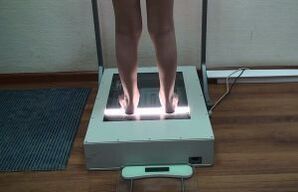
Hallux Valgus sections
The degree of gravity of the Khalus valgus is determined by the angle between the first metatarsal bone and the second, and the angle of difference from the first metatarsal bone.There are three stages of this disease development:
- Degree Hallux Valgus is characterized by minimal differences: younger than 12 degrees, and the thumb difference does not exceed 25 degrees.At the same time, patients cannot be completely absent in pathognomic symptoms and visual changes are almost invisible.
- The Khalus valgus manifests itself 2 degrees with an increase in the inter -filo corner to 18 degrees, and the first finger is rejected at more than 25 degrees at this time.Deformation develops painful feelings and discomfort when wearing the usual shoes.With excessive physical surge, pain increases.The convex part of the plus bone head is constantly rubbed, hyperemic, swollen, indicating an inflammatory process.
- The Hallux valgus is manifested with a significant curvature of 3 degrees, the angle between the metatarsal bones exceeds 18 degrees, the first and the second fingers crossing.There is a significant red swelling in the inside, painful on the palpation.Wearing any shoe becomes impossible due to pain, and patients are constantly affected by sparing the affected limb.
The treatment tactic depends on the neglect of the pathological process.In the first phase, you can use conservative methods to use tires and other fasteners.The next stage requires urgent surgery without which the foot may be deformed, other unwanted complications occur.
Halus treatment methods valgus
The effects of pathological factors should be ruled out before starting treatment.Above all, you need to reduce your body weight.For patients, it is recommended to play sports and lead an active lifestyle.An important aspect is that it is forbidden to apply forces to the affected limb when making physical efforts.Appointment of diet treatment is an important step in treating Khalus valgus.A specialist may recommend an effective diet, but it must necessarily contain products rich in vitamins and minerals that promote the condition of the affected joint.
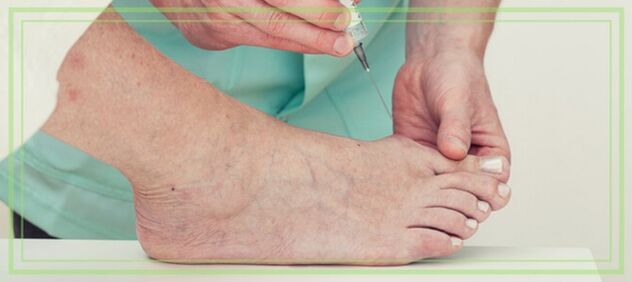
Orthopedic tires and fasteners
They are used to constantly fix the deformed plus bone and finger to the rest of the foot.You can use rigid locks - tires that are not allowed to move your finger when fastened to your feet.Such a device is used during sleep and long rest.You can contact silicone fasteners.There are silicone fasteners that are attached to the thumb and attached to all fingers.The main advantage of this development is that it can walk in the shoes.At the same time, the extra bone is effective and the latch itself is virtually unreasonable.























